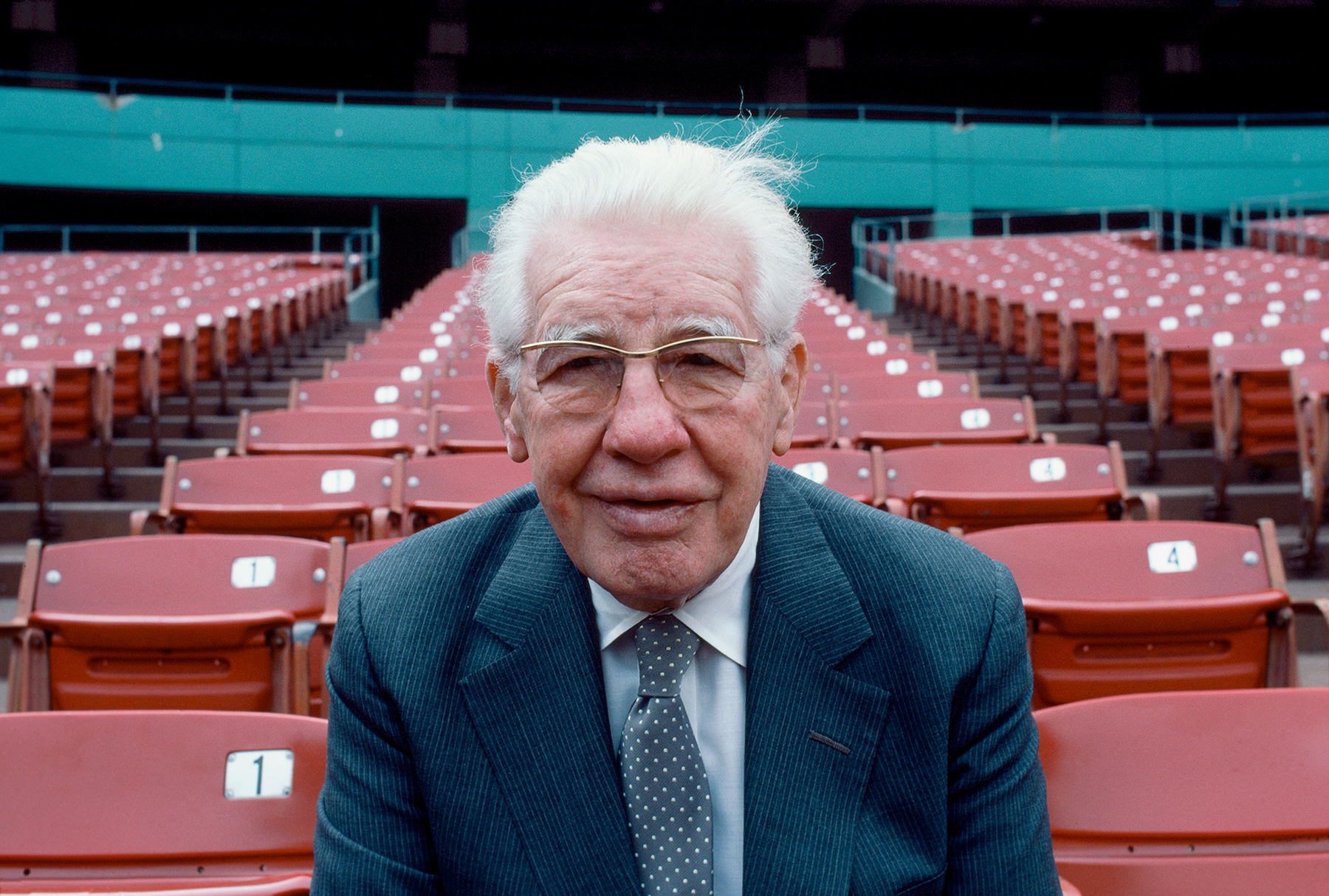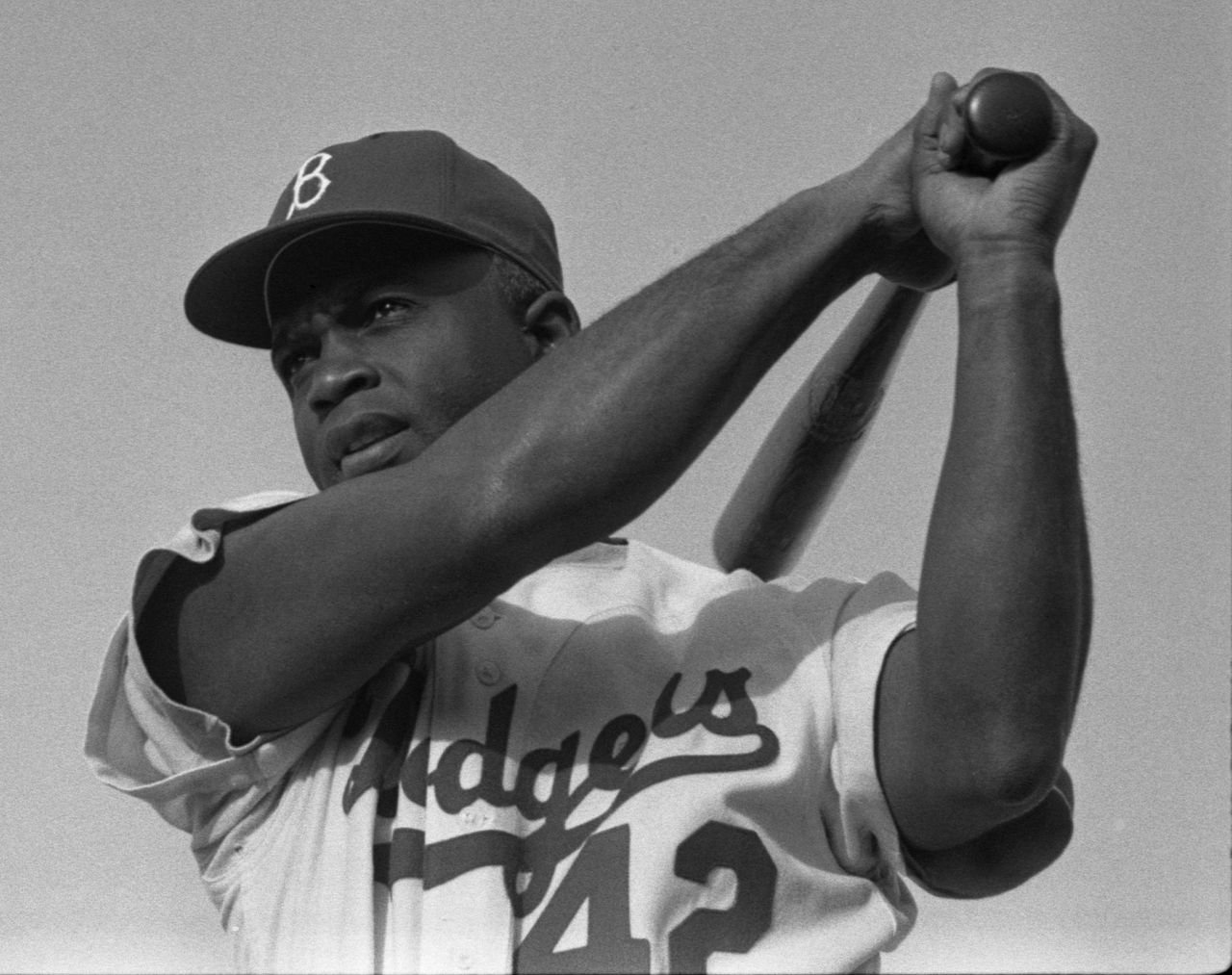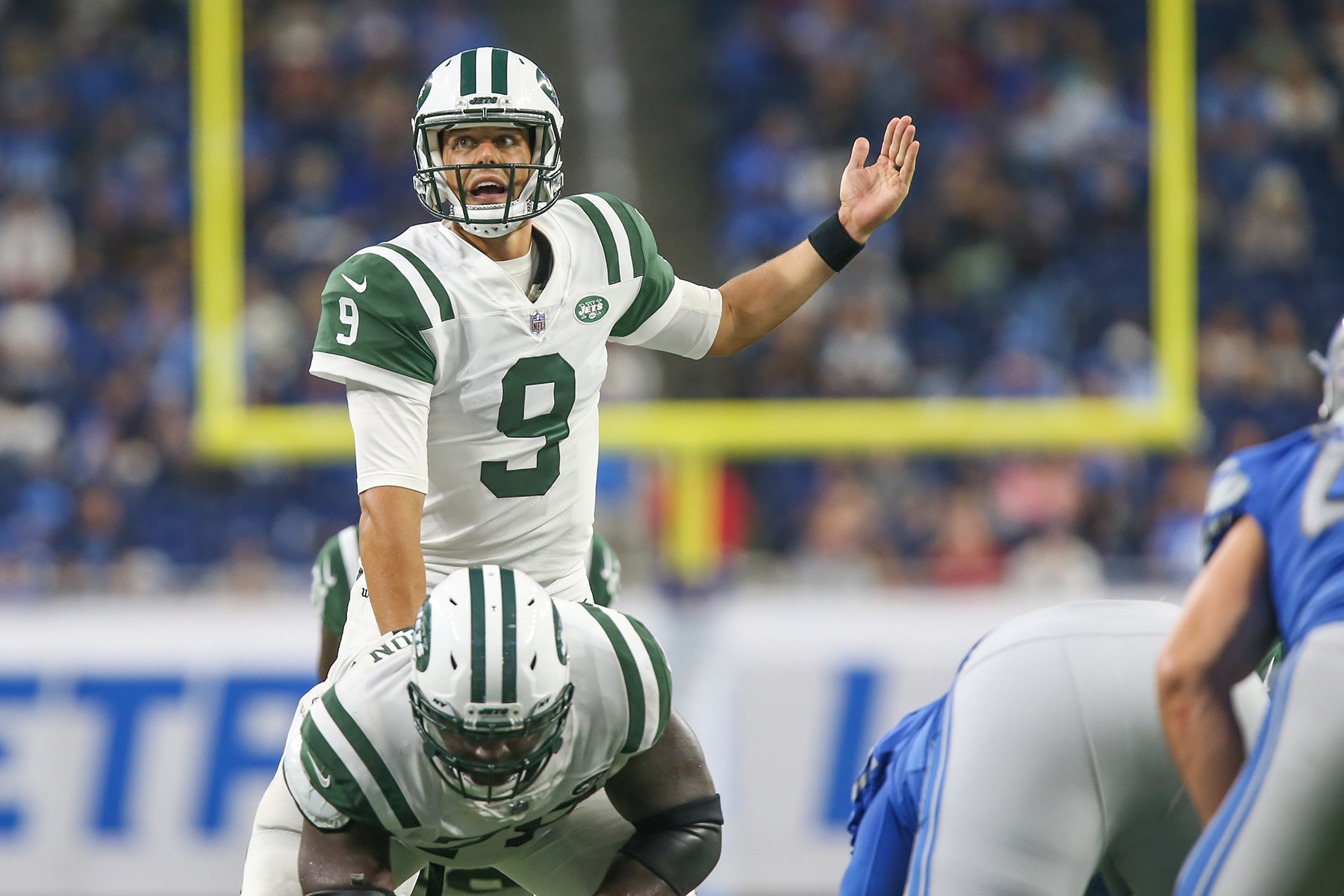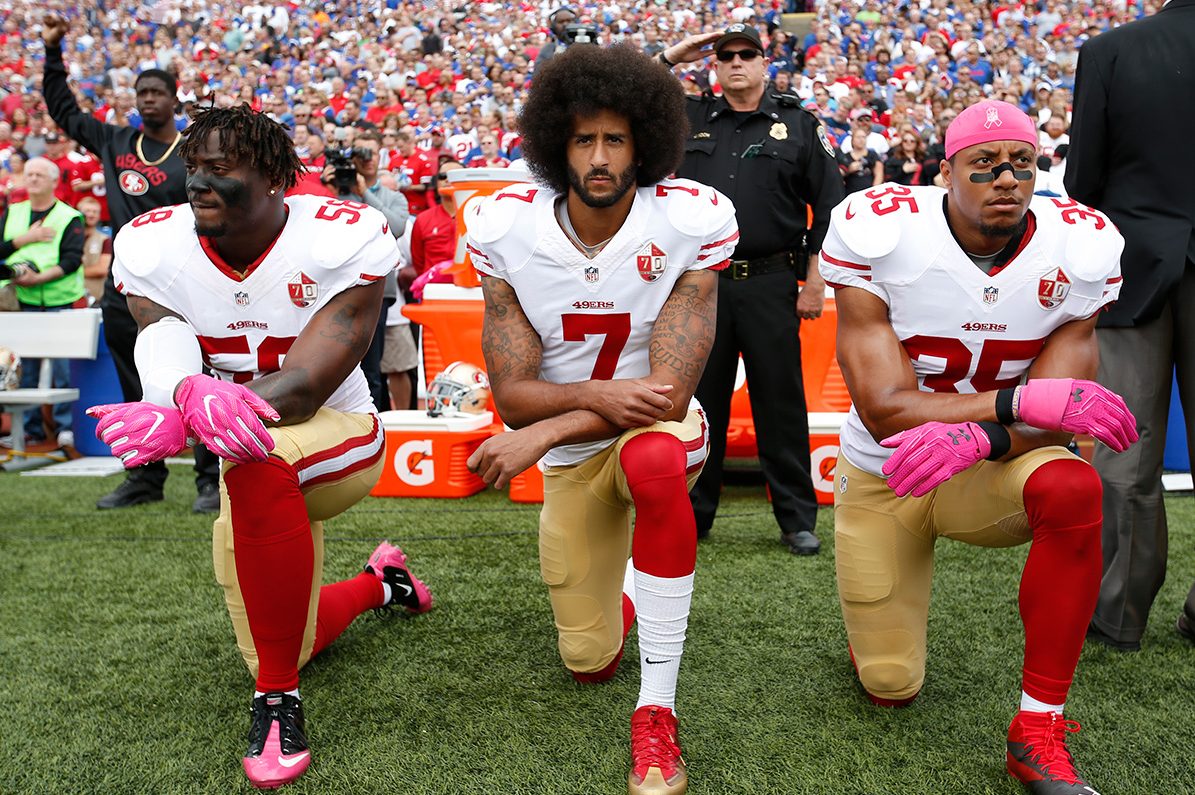If you’ve been following the developing Colin Kaepernick story like I have, you’ll know that it’s anything but cut and dry.
The former NFL quarterback, who last August began a silent sideline protest during the playing of the national anthem—either sitting or kneeling while it played—opted out of his contract with the San Francisco 49ers this past March and became a free agent. (Kaepernick later said that his protest was for all “oppressed” people.) While he could’ve landed just about anywhere in the NFL, given his arguably better-than-average talent and record—he’s both a rushing and passing threat, has a 4-2 record in the playoffs, and took a team to the Super Bowl in 2013—Kaepernick’s been sidelined ever since. Not a single one of the 32 teams in the league has yet to offer the ex–star quarterback a job in 2017. That’s pretty telling.
Many perceive Kaepernick’s blacklisting to be because of his lack of remorse in protesting the anthem—and his continued action, which has included everything from handing out suits at a parole office to donating to charities such as Mothers Against Police Brutality and Meals on Wheels. He’s pledged to give $1 million to causes, and at press time, he’s $800,000 into that goal.
Also, at least one former opponent, Buffalo Bills running back LeSean McCoy, recently called Kaepernick a “distraction” and intimated that Kaepernick was not even a good enough player for a team to roll the dice on.
Even President Trump has taken shots at the player and patted himself on the back for keeping Kaepernick unemployed.
But I’d like to argue that there’s at least one team in the league—whether they know it yet or not—that would be the perfect fit for Kaepernick and would put an end to this uppercase Quarterback Controversy once and for all. The team? The Pittsburgh Steelers.
Now, before members of Steelers Nation lower the boom on me for this, know this: I’ve been a faithful member of your ranks for 20-plus years. Long before I could string sentences together coherently and was a career journalist, my father, an English professor and Shakespeare expert who grew up in the Squirrel Hill neighborhood of Pittsburgh, invited me to a Steelers-watching party. It turned out that he and two of his English Department colleagues, along with both of their wives, were diehard Steelers fans, who served an endless supply of Rolling Rock beer and traditional Sunday-football junk food (it was the latter that I was most interested in at the time). They would sit around the TV, occasionally bringing up work, but mostly yelling for Bubby Brister, Neil O’Donnell, or Kordell Stewart to “go, go, go!” or for their defensive lines to put a hurting on the opposing team’s passer. That was my Sunday school education, when I wasn’t hunkered down at the local synagogue. It became my second religion.
And while I don’t own an Antonio Brown jersey, have never been to Heinz Field for a game, and don’t even watch every single game on TV like my dad and his crew did, I do follow the team religiously, own a few too many of their football cards, and read anything I can get my hands on about them.
One of the topics that seems to come up again and again when reading about the Steelers is its groundbreaking record on race relations in the NFL.

Rob Ruck, a professor of history at the University of Pittsburgh and co-author of Rooney: A Sporting Life, tells me that when he was writing his master’s dissertation in the late ’70s on the Pittsburgh negro league and sandlot baseball clubs, while interviewing African-American men who had played on the teams for the project, the name “Art Rooney” kept coming up. “I had done a lot of work for the black community before that, [but] I had never heard a white person being spoken about with such regard and affection as they had for Rooney,” says Ruck. (He would end up interviewing Rooney and his son, Dan, extensively, over the years.)
Art Rooney, of course, was the founding owner of the Pittsburgh Steelers. As Ruck tells me, when Rooney launched his first semi-pro football teams, one of which became an NFL team known as the Pittsburgh Pirates in 1933—later changing its name to the Steelers—he included African-American players on their rosters. The first African-American NFLer on his squad was a man by the name of Ray Kemp—basically, the Jackie Robinson of the league. “[Rooney] always had a rep; he never abandoned the north side of Pittsburgh where he lived and where his son, Dan, moved back to and was living when he died a couple months ago,” explains Ruck. “He never abandoned his community as it turned poorer and blacker; he’d be out on the streets during the Martin Luther King riots, [and] nobody would touch him.”
Ruck says Art instilled the same ethos in his son, Dan, who was instrumental in weaving the “Steel Curtain,” or defensive line that led the Steeler franchise to Super Bowl victories in ’74, ’75, ’78, and ’79. Those teams would include a number of star African-American players, including quarterback Joe Gilliam, who started the first six games of the ’74 season (pre-dating Terry Bradshaw’s tenure); running back Franco Harris, maybe best known for his “immaculate reception“; acrobatic wide receivers John Stallworth and Lynn Swann; and defensive tackle “Mean” Joe Greene, whom Ruck says was particularly close to Dan (Greene, as you may remember, plays into one of the most famous TV ads of all time).
Dan also was the force behind what became known as the Rooney Rule, which involves requiring teams to interview at least one minority candidate when searching for a new head coach. Although it’s not a perfect system by any means, it has been all but proven true by the Steelers’ own head coach, Mike Tomlin, and the success he’s had on the gridiron (in 2009, he became the youngest head coach in NFL history to land a Super Bowl victory; he was the Steelers organization’s first-ever African-American head coach).

Does Ruck think the Steelers would be a good fit for Kaepernick? He believes that as soon as a starting quarterback goes down in the league—whether or not he’s on the Steelers—decisions will begin to get made. And that could present an opening for Kaepernick. Ruck also argues that Charlottesville has been somewhat of a turning point, making “a lot of people find their voices and conscience.” He cites Branch Rickey’s signing of Jackie Robinson in the baseball world as a prime example. Baseball owners at the time assumed there’d be a backlash amongst fans and that white ones would boycott games, putting a sizable dent in ticket sales. “Ironically, the Dodgers set attendance records that year when they brought Robinson up,” notes Ruck.
I think it’s also worth noting that the team recently signed one of the biggest quote-unquote distractions in league history, quarterback Michael Vick. As I’m sure you’re aware, Vick spent nearly two years in prison for his involvement in a dog-fighting ring and for lying to a judge—but somewhat miraculously won NFL Comeback Player of the Year award honors the year after he was released. Vick acted as a backup to Steelers’ quarterback Ben Roethlisberger during the 2015 campaign, winning a pair of games for the team. He didn’t do much off the bench, but how many backups really do? (Obviously, Tom Brady is the exception to that rule.)
What’s notable here is that the Steelers have dealt with a number of player distractions in recent history—and have handled all of them quite eloquently. Last season alone, outside linebackers coach Joey Porter (also a former Steeler) was arrested and a locker-room Facebook video taken by star wide receiver Antonio Brown (see above) caught the ear of the national news media, much to the chagrin of the organization. (Neither coach nor player was suspended or released—but Brown was fined $10,000 by the Steelers.) In the mid-’90s, Steelers’ running back Bam Morris was cut after pleading guilty to felony drug possession; while running back LaGarrette Blount, who was arrested on drug possession with star running back Le’Veon Bell—and then exited a game before it ended because of lack of carries—saw his release soon thereafter. (Bell has stayed on the team but not without his own troubles; see below.)
It remains to be seen how wide receiver Martavis Bryant, who was suspended for the entirety of last season for violating the league’s substance-abuse policy, will fare with ownership going forward. And despite Bell being suspended four and three games during the 2015 and 2016 seasons, respectively, he’s been a protected member of the team, as his numbers seem to far outweigh his level of distraction (which seems to be, in part, what McCoy was arguing during his assessment of Kaepernick).
But distractions on NFL teams really live and die in just a few places: the media; an owner or head coach’s office; and the locker room. And the Steelers’ locker room seems to be the type of place where Kaepernick would face a rather harsh jury of his peers—one that would support him but not coddle him.
Last year, ESPN pieced together a first-person account from many Steelers players of what it’s like to be in the team’s locker room. Linebacker Jarvis Jones referred to it as a “no-judgment zone,” also telling a story about how he was pulled over for speeding by a white police officer, and before the officer even approached his vehicle, pulled out his service weapon. Running back Bell said, “For us, when we see race or things play out from the outside, we can discuss it and we can still have an open mind to what someone is saying. Our locker room is very open, and it should be like that.” You can’t help but wonder if Kaepernick’s name made it into those discussions last season, and what exactly was said about him.
But maybe the most telling quote in ESPN’s story came from left tackle Alejandro Villanueva, a West Point graduate and former Army Ranger: “African-Americans are not a minority [in NFL locker rooms],” he told ESPN. “They are a majority. So their voices are going to be heard. The one thing I can truly take away from this: I feel something inside is not right. My teammates that I care so much about wake up in the morning with the feeling of not being equal.”

It’s possible that feeling Villanueva had last season has something to do with why Kaepernick is still unemployed—even after glaring holes in quarterback depth charts have found their way into the 24/7 sports news cycle. Will Cleveland Browns’ rookie DeShone Kizer need a backup, if Brock Osweiler is traded? Absolutely. Are the New York Jets in constant need of something—anything—to get W’s? Yes. What about the Jacksonville Jaguars, Buffalo Bills, or Miami Dolphins? Even the Baltimore Ravens—the Steelers’ divisional arch rivals—have been name-dropped as in need of QB depth. And Kaepernick has apparently found support from the team’s head coach and general manager, but not its owner.
But look, I’m not here to present my lacking skills in NFL player personnel management or tell any of these teams what to do with their millions of dollars. What I can do, though, is suggest that the Pittsburgh Steelers welcome Kaepernick with open arms and at least try him out. (Theoretically, roster moves would need to be made, too.) Despite Kaepernick being at the center of a polarizing debate—one that not only affects the NFL, but has also spilled into our day-to-day lives, whether it be in South Carolina or Charlottesville or elsewhere—let the Steelers’ locker room swallow him whole and spit him out, or just simply, embrace him.
Because realize that whenever Roethlisberger’s shoulders or knees or ribs crunch to the semi-thawed ground this winter—and he doesn’t immediately get up—that he has a capable fill-in behind him that has been literally carrying the weight of the (sports) world on his shoulders and will be more than just a decent replacement. He’ll be a tough, smelted Steeler.
Whether you’re looking to get into shape, or just get out of a funk, The Charge has got you covered. Sign up for our new wellness newsletter today.
























